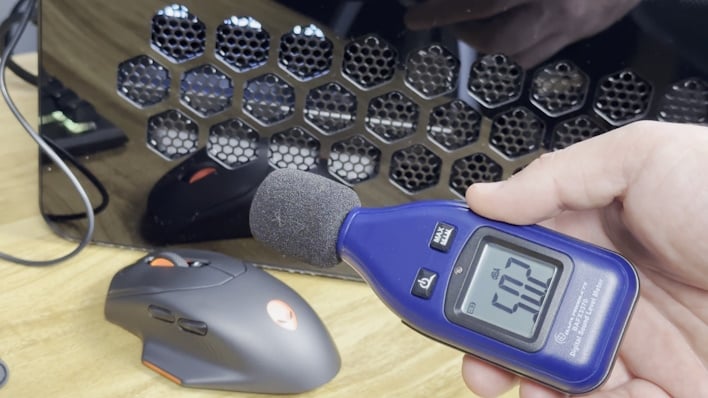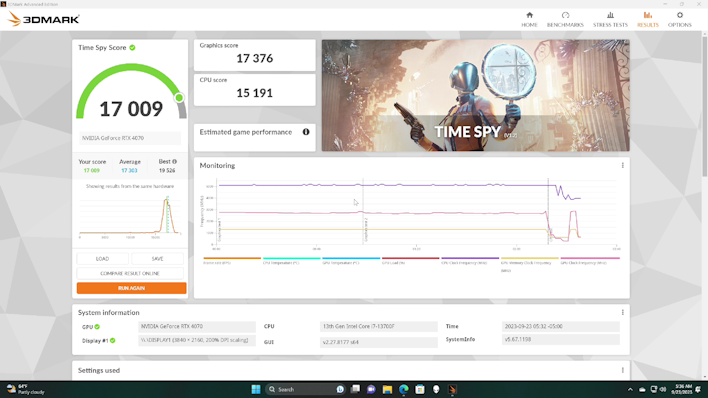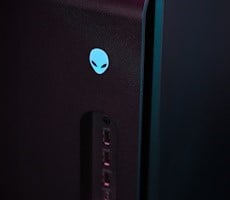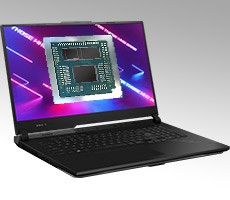Alienware Aurora R16 Gaming Desktop Review: A Civil Redesign
More importantly, we spent some time monitoring noise levels and temperatures while we subjected the new Alienware Aurora R16 to a battery of gaming tests. At idle, this machine is dead-silent. Right up next to the case, we registered 36-37 dBA, and nobody is going to sit as close as the sound meter was while measuring acoustics. Even with a CPU-only load of Cinebench R23 running on a loop, it was barely any louder than those numbers. When a 65 Watt CPU meets a 240mm radiator on an AIO liquid cooler, quiet things happen. This machine is tame in that regard.

Finally, our most interesting acoustic test of Alienware Aurora R16: fully-loaded CPU and GPU workloads, with both Cinebench R23 as well as 3DMark's Speed Way DX 12 Ultimate stress test running simultaneously. We actually had to get about four inches from the machine with both Cinebench R23 and 3DMark Speed Way stress test running to get a sound pressure meter reading of 50 dBA (seen below). At normal distances in the 12-18" range that noise floor drops to 43 dBA. Under most circumstances, however, including this overwhelming load, the Aurora R16 is otherwise very quiet.

As with the Alienware Aurora R15 before it, and thanks in part to a reduced TDP from the Core i7-13700F and GeForce RTX 4070, Dell and Alienware again nailed the thermal and acoustic properties. Just for fun, in Alienware Command Center, we cranked the fans to the maximum and measured 70 dBA, with every fan running at 2200 RPM. All of that is to say that if the company chose to offer this system with a higher-power CPU and GPU, there's plenty of headroom. As it stands, the ridiculously cool and quiet results just make this system a pleasure to use.

We can also see here that the Alienware Aurora R16 doesn't struggle to maintain its performance over time. The quiet fans aren't a harbinger of dropping clock speed over time due to heat or anything. It stays at its peak performance throughout the run.

There's virtually no throttling to speak of with the Alienware Aurora R16 because the CPU and GPU remain nice and cool, even under a sustained load. While stressing both the CPU and GPU with 100% workloads, the CPU ran in the low 50°C range -- which is great - while the GPU hovered around 70°C.
Alienware Aurora R16 Review Conclusions
The Aurora R16 from Alienware is a solid option, in terms of midrange prebuilt gaming PCs. The specs are well-balanced here. For instance, there's little need to pair a GeForce RTX 4070 with a Core i9-13900KS from a high-resolution gaming perspective, while pairing the graphics card with a Core i5-13400F might be seen as "cheaping out". As it is, the 65 Watt Core i7-13700F and GeForce RTX 4070 go together quite well, to the point that at 4K in every title we tested, this system keeps up with our testbeds. From this perspective, the Aurora R16 is a big win, and the system achieves all this while being whisper quiet under load.Looking at the system itself, some folks might not be as drawn to the design of the Aurora R16, versus the more eye-catching designs of the previous generation (and still higher-specked) Aurora R15. That's not to say that Alienware's Legend 3 design language is plain, per se; it just shies away from the rounded UFO-looking accoutrement of Legend 2 while carrying forward all of the internal design improvements of the previous iteration. The footprint is a bit smaller, more in line with other Micro ATX mid-tower designs, and there's still plenty of RGB bling for gamers that love the look.
If performance is good, thermal performance is on point, and the looks are handsome, what's the drawback? The only real downside is that a couple of components are proprietary designs in this config. In addition to the chassis, the Aurora R16's motherboard -- which is shared with the Aurora R15 before it -- is not a standard micro ATX motherboard, meaning a replacement will need to come from Dell or Alienware. Many pre-builts made with off-the-shelf parts won't have this drawback. In addition, the power supply is another proprietary design, for which replacements aren't as readily available as a standard ATX design. This is expected and even necessary in a laptop, but a little disappointing in a desktop. We're big fans of right-to-repair laws, but it's hard to repair proprietary components. At least everything else is standard, from the DIMMs to the M.2 drives and even the graphics card.
Alienware offers a base model of the Aurora R16, which includes a Core i7-13700F, GeForce RTX 4060, 16 GB of DDR5-5600, and a 1 TB SSD for $1,299. That system has air cooling rather than the closed-loop cooler, and it bears a solid side panel rather than the clear, vented one on our review unit. To get up to our review unit's spec isn't quite as much as one might expect, however. Subbing in a GeForce RTX 4070, adding twice the RAM and a second SSD, and adding improved cooling and a clear side panel, brings the price up to $1,949. Options including a GeForce RTX 4070 Ti (which requires upgrading to the 1,000W Platinum Rated power supply) and a Core i9-13900F are available, as well.
The Aurora R16 from Alienware is not for everyone, but the Aurora R16 is focused on a market where gamers lack either the time or the inclination to roll their own, while offering a single point of warranty coverage and very good performance. For those folks in the market to get into PC gaming the easy way, with a mid-tier to upper-range gaming system, the Alienware Aurora R16 comes HotHardware Approved.









